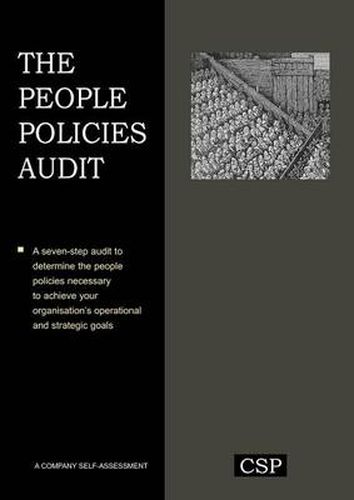Readings Newsletter
Become a Readings Member to make your shopping experience even easier.
Sign in or sign up for free!
You’re not far away from qualifying for FREE standard shipping within Australia
You’ve qualified for FREE standard shipping within Australia
The cart is loading…






This title is printed to order. This book may have been self-published. If so, we cannot guarantee the quality of the content. In the main most books will have gone through the editing process however some may not. We therefore suggest that you be aware of this before ordering this book. If in doubt check either the author or publisher’s details as we are unable to accept any returns unless they are faulty. Please contact us if you have any questions.
This audit is designed to help you understand the full impact of your existing people policies (some of which may never have been formulated as actual policies) and to bring them into line with your overall business strategy. In this way, your people policies will reinforce rather than obstruct the strategic vision and changes that you are trying implement. This process of policy alignment begins with a 30-point questionnaire to assess the level of HR best practice achieved by your organisation. (If you are using other HR audits, you could begin here and run this audit at regular intervals to measure the impact of the many changes you will be making to your systems and strategies as a result of using the other audits). The audit then takes you through the following 7 steps: 1.Clarify the strategic challenges now confronting your organisation 2.Establish your organisation’s existing capabilities, strengths and weaknesses 3.Use the relevant audit matrix to calculate the people-related actions/policies needed to give maximum support to your strategic objectives 4.Analyse existing people policies and their relevance to your business needs 5.Establish new and amended policies to make the required actions happen 6.Establish processes to ensure suitable changes are continuously devised and implemented 7.Measure the impact of changes already made. At each step, the audit includes checklists, assessments and sample questions. It also includes detailed guidelines to help you interpret the results. Finally, there is an extended people policies survey covering resourcing, learning and other key people issues.
$9.00 standard shipping within Australia
FREE standard shipping within Australia for orders over $100.00
Express & International shipping calculated at checkout
This title is printed to order. This book may have been self-published. If so, we cannot guarantee the quality of the content. In the main most books will have gone through the editing process however some may not. We therefore suggest that you be aware of this before ordering this book. If in doubt check either the author or publisher’s details as we are unable to accept any returns unless they are faulty. Please contact us if you have any questions.
This audit is designed to help you understand the full impact of your existing people policies (some of which may never have been formulated as actual policies) and to bring them into line with your overall business strategy. In this way, your people policies will reinforce rather than obstruct the strategic vision and changes that you are trying implement. This process of policy alignment begins with a 30-point questionnaire to assess the level of HR best practice achieved by your organisation. (If you are using other HR audits, you could begin here and run this audit at regular intervals to measure the impact of the many changes you will be making to your systems and strategies as a result of using the other audits). The audit then takes you through the following 7 steps: 1.Clarify the strategic challenges now confronting your organisation 2.Establish your organisation’s existing capabilities, strengths and weaknesses 3.Use the relevant audit matrix to calculate the people-related actions/policies needed to give maximum support to your strategic objectives 4.Analyse existing people policies and their relevance to your business needs 5.Establish new and amended policies to make the required actions happen 6.Establish processes to ensure suitable changes are continuously devised and implemented 7.Measure the impact of changes already made. At each step, the audit includes checklists, assessments and sample questions. It also includes detailed guidelines to help you interpret the results. Finally, there is an extended people policies survey covering resourcing, learning and other key people issues.